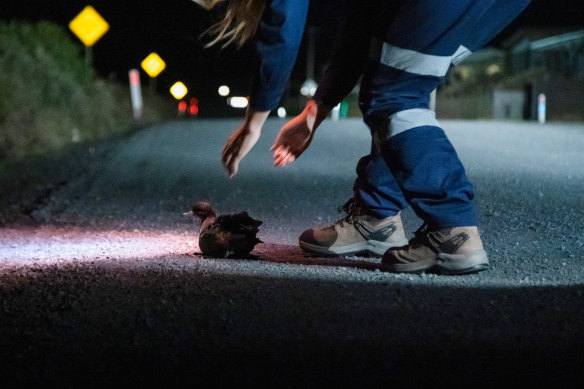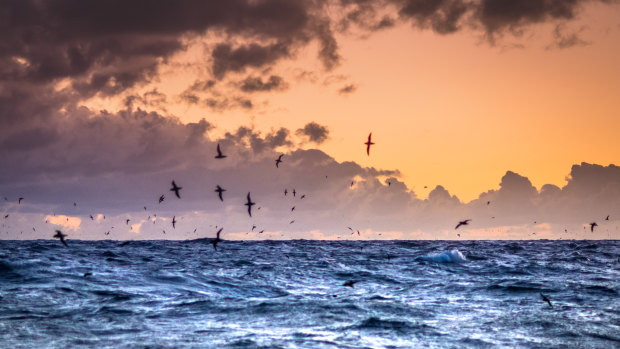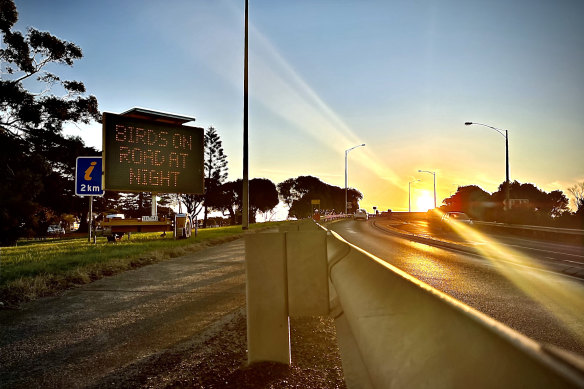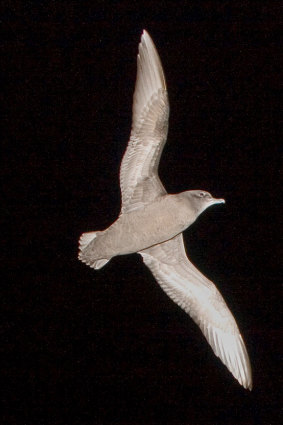
On a wing and a prayer, Phillip Island residents turn off the lights to give some chicks a chance
04/16/2023Save articles for later
Add articles to your saved list and come back to them any time.
It’s all about the wind. When Phillip Island’s short-tailed shearwater chicks emerge from their sandy burrows to make their first 16,000-kilometre flight, they wait for a powerful wind – 40km/h or even stronger – to help them soar.
They also rely on the moon to navigate. But when they see the shine of artificial lights they can become disorientated, crash-landing on roads and causing damage to themselves and motorists.
Shearwaters are drawn to street lighting and land on roads, presenting a danger to themselves and distracting motorists.
Phillip Island Nature Parks, which manages the popular little penguin parade, is calling on residents and local businesses in the bird’s flight path to switch off their lights at night for the next fortnight, as a record-breaking 700,000 short-tailed shearwater chicks take to the sky.
Every year, these short-tailed shearwater fledglings leave their sandy burrows on Phillip Island and fly 16,000 kilometres to Alaska in late April or early May.
“A successful breeding season means more birds will attempt the annual migration, so we are calling on locals to help eliminate unnatural light sources and take extra care on the roads,” said Dr Duncan Sutherland, the deputy manager of research at Phillip Island Nature Parks.
This breeding season had produced the second-highest number of chicks on the island in the past decade. “This will give the young shearwater chicks the best chance of a safe departure this year,” Dr Sutherland said.
Shearwaters travel an extraordinary 16,000 kilometres to get from Australia to Alaska.
There has been a particular issue with shearwaters flocking to the San Remo bridge lights, at the gateway to the island, so electricity provider AusNet Services will switch off the lights on the bridge for up to 10 nights during the peak departure period.
“This will give the young shearwater chicks the best chance of a safe departure this year.”
So far, 30 businesses have signed up to switch off their lights during migration season. One of these is Shorelec, an electrical business in San Remo that usually boasts a window display filled with bright lights after dark. But not this year.
A sign warns motorists at Phillip Island to look out for birds.
“When they turn the lights off on the bridge it can be eerie, everything in the town is just dark,” says Shorelec staff member Melissa Dagg. “The whole street gets on board, we’re trying to educate people.”
Shops put signage in their windows to explain the campaign, and Dagg even has a life-sized plastic shearwater at the front counter to spark conversations about wildlife conservation. “When they [the adult birds] return to their nests for the evening you can go down and see it. The sky is full of them at dusk,” she said.
A shearwater in flight at night.
Short-tailed shearwaters migrate to Phillip Island (and other places) from the Northern Hemisphere every year to raise their chicks. In early April, the adult seabirds start the long journey back, leaving behind their chicks to fledge (grow adult feathers) and begin their own migration weeks later.
This breeding season has produced the second-highest number of chicks on the island in the past decade, with an 80 per cent hatching success rate for shearwater eggs.
The impact of light pollution on migratory animals such as birds, turtles and Bogong moths, has been well documented. These animals use light from the stars or moon to guide their migration and glow caused by towns and other sources of artificial light can cause them to lose their way.
Phillip Island Nature Parks has installed environmentally-sensitive lighting at the Penguin Parade visitor centre to help protect both little penguins and shearwater birds.
“We have seen some very positive results…with very few shearwaters landing around the carpark, which is incredible given we are in the middle of a substantial shearwater colony,” Dr Sutherland said.
Get to the heart of what’s happening with climate change and the environment. Our fortnightly Environment newsletter brings you the news, the issues and the solutions. Sign up here.
Most Viewed in Environment
From our partners
Source: Read Full Article





